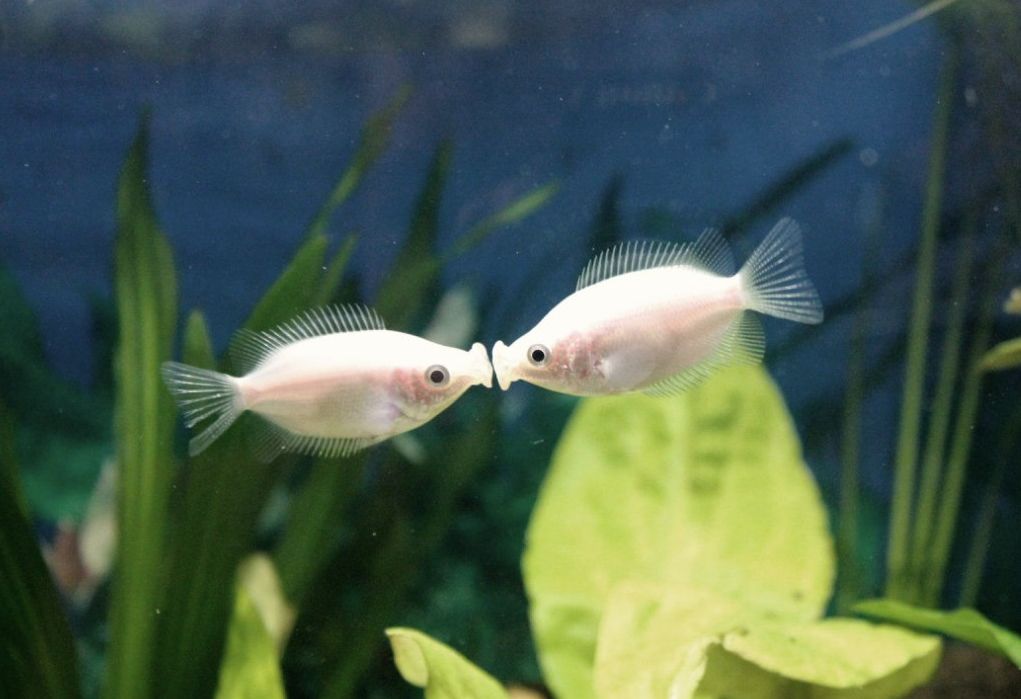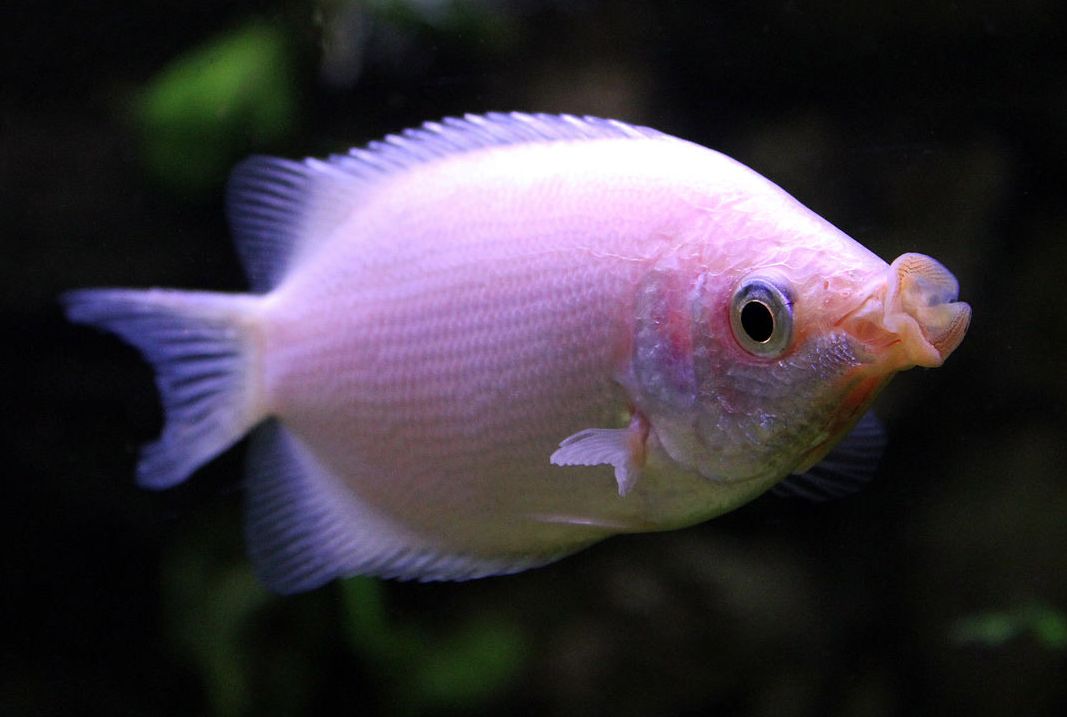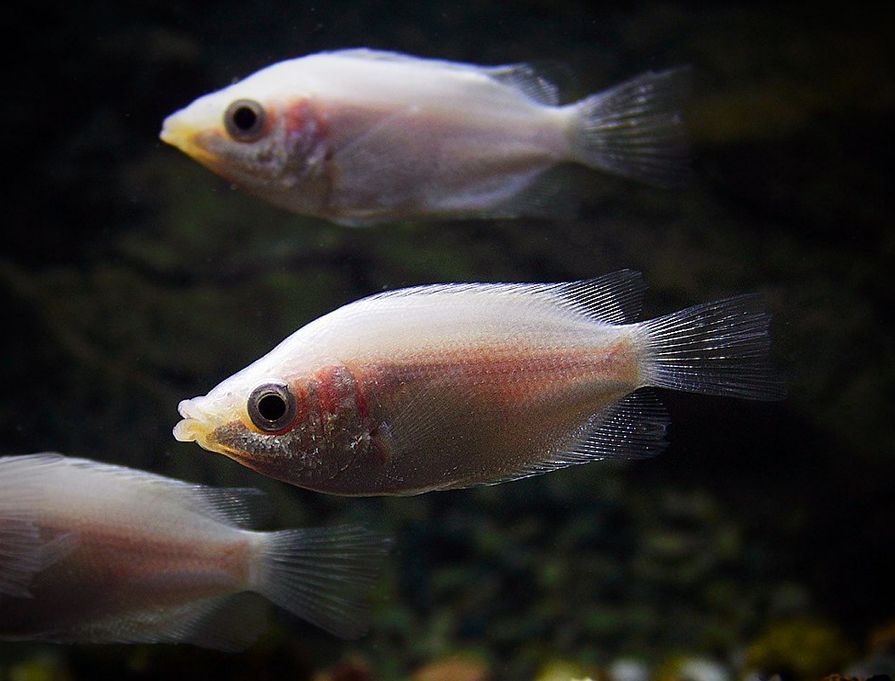The kissing gourami is not particularly vibrant in color, but its behavior is truly fascinating. The name “kissing gourami” comes from its unique mating display, where two fish face each other and swim slowly in tandem. During this dance, their mouths touch briefly, resembling a kiss. This interaction is often a courtship ritual, showcasing the fish’s social nature and providing insight into their breeding behaviors. Observing this behavior can be a delightful experience for aquarists and fish enthusiasts alike.

Contents
Habitat in the wild
The kissing gourami belongs to the family Helostomatidae, which is notable for including only two species: the common kissing gourami and the pink kissing gourami. Both species are native to Southeast Asia and are favored by aquarists for their unique behavior, particularly their courtship ritual that resembles kissing. During this interaction, the fish lock their lips together, adding an intriguing dynamic to their social interactions.
In their natural habitat, kissing gouramis are commonly found in the freshwater ponds of Southeast Asia, including many regions of Indochina and certain islands of the Malay Archipelago, such as Java, Sumatra, and Kalimantan. They have also been introduced to areas like Sri Lanka, the Philippines, New Guinea, and even Colombia. These fish thrive in shallow waters with dense vegetation, preferring slow-flowing areas such as lakes, backwaters, ponds, and bogs. The abundance of aquatic plants in these environments offers plenty of hiding spots and shelter, which are essential for their safety and comfort.
Kissing gouramis are often encountered in regions with submerged plants, floating vegetation, and overhanging branches. Their native waters typically have warm temperatures, ranging from 24°C to 30°C (75°F to 86°F), and a pH level between 6.0 and 7.5, creating an ideal environment for their growth and reproduction.
Like other species in the climbing perch family, kissing gouramis are adapted to both gill breathing and atmospheric air breathing, allowing them to survive in oxygen-deficient waters. This adaptability has made them suitable for pond aquaculture, and their generally low aggressiveness enables them to coexist with other fish species.
Their diet consists of both plant-based and protein-rich foods. The well-developed gill apparatus allows them to filter zooplankton from the water, while their small teeth enable them to rasp algae from submerged surfaces and feed on aquatic plants. In addition to this diet, kissing gouramis can also catch aquatic insects near the water’s surface, showcasing their versatility as foragers.

Description
Latin Name
The kissing gourami’s Latin name, derived from the Greek words ἧλος (helos), meaning ‘nail,’ and στόμα (stoma), meaning ‘mouth,’ reflects its distinctive features. The specific epithet temminkii honors Dutch zoologist Coenraad Jacob Temminck.
Size
Kissing gouramis can grow quite large, reaching lengths of up to 30 cm (12 in) in the wild. In aquarium settings, they typically grow to about 10–15 cm (4–6 in). Their size can vary significantly based on environmental factors, diet, and genetics. Proper care, including a balanced diet and suitable tank size, is crucial for their growth and overall well-being.
Lifespan
Kissing gouramis can enjoy a relatively long lifespan, typically living 8 to 10 years under ideal conditions, with some sources even noting lifespans of up to 25 years. Key factors influencing their longevity include proper aquarium maintenance, appropriate water conditions, a balanced diet, and a stress-free environment.
Body and Color
The body of the kissing gourami is flattened and relatively tall, resembling other members of the Osphronemidae family. In their natural habitat, they exhibit a foliage green coloration with opaque brown fins and black vertical stripes. In aquariums, their coloration may range from rose to orange-pink, adorned with silvery scales and transparent fins. There are also variations with reduced pigmentation, appearing almost albino except for their black irises. An artificially bred variant, known as the balloon pink or dwarf kissing gourami, features a shortened body but generally has a shorter lifespan.
Fins
Kissing gouramis have large, low-set pectoral fins, with the front rays of the abdominal fins being elongated. The dorsal and anal fins are positioned at similar levels, with the dorsal fin comprising 16–18 coarse rays and 13–16 soft rays, while the anal fin consists of 13–15 coarse rays and 17–19 soft rays. Near the tail, both the dorsal and anal fins extend due to longer soft rays, and the tail fin is rounded with a notch. The lateral line features approximately 38–43 scales, divided into a longer front section and a shorter back section.
Lips
The name “kissing gourami” stems from their characteristic lip movements during feeding, aggressive displays, and courtship rituals. One of their most distinctive features is their sharply defined, flexible lips, which contain hundreds of tiny, horny teeth arranged in rows along the edges. Interestingly, they lack other teeth inside their mouths.
Labyrinth Organ
Kissing gouramis possess a unique respiratory adaptation known as the labyrinth organ, which is common among fish in the Osphronemidae and Anabantidae families, including gouramis and bettas. This organ allows them to breathe atmospheric air, supplementing the oxygen they extract from water through their gills. This adaptation is especially beneficial in oxygen-deprived or stagnant waters, such as shallow puddles and swamps, where gouramis often thrive.
When a kissing gourami surfaces, it gulps air into the labyrinth organ, a highly vascularized structure located above the gills, facilitating efficient gas exchange. In home aquariums, it’s essential to provide access to the water’s surface to support their unique breathing needs. A well-designed tank with ample surface area, floating plants, and minimal water agitation can enhance their health and well-being.
| Characteristic | Description |
|---|---|
| Scientific Name | Helostoma temminkii |
| Common Name | Kissing Gourami |
| Family | Helostomatidae |
| Origin | Southeast Asia, freshwater habitats |
| Size | Up to 12 inches (30 cm) in length |
| Lifespan | 5 to 10 years in captivity |
| Behavior | Social, known for “kissing” behavior during courtship |
| Color | Various shades of pink, red, or peach |
| Habitat | Slow-moving rivers, streams, ponds, and swamps |
| Water Temperature | 24°C to 30°C (75°F to 86°F) |
| pH Level | 6.0 to 7.5 |
| Diet | Omnivorous, eats plants, insects, and small crustaceans |
| Tank Size | Minimum 40 gallons for a single fish |
| Tank Conditions | Plenty of hiding spots, floating plants, and cover |
| Compatibility | Generally peaceful, but can be aggressive towards own species |
| Breeding Behavior | Mouthbrooders, male carries eggs and fry in his mouth |
| Difficulty Level | Beginner-friendly with proper care and conditions |

Difficulties in keeping
Kissing gouramis are relatively undemanding fish, but they require a spacious tank to thrive. As they mature, they can become boisterous and territorial, which may lead to aggressive behaviors, especially among males. Because of this tendency, kissing gouramis are better suited for aquarists who have some experience in fishkeeping. Providing a well-maintained environment with plenty of space and hiding spots will help mitigate territorial disputes and ensure a harmonious community tank.

Care and keeping in a tank
Tank Size
The appropriate tank size for kissing gouramis is crucial for their health and well-being. These fish can grow up to 30 centimeters (12 inches) long, so ample space is necessary. A minimum tank size of 40 gallons is recommended for a single adult kissing gourami, allowing enough room for comfortable swimming and territory establishment. If you plan to keep multiple kissing gouramis, the tank size should be increased to accommodate their social dynamics and territorial behaviors. A larger tank not only benefits the fish by providing space but also aids in maintaining stable water quality, as larger volumes can better absorb fluctuations in water parameters.
Kissing gouramis exhibit territorial behavior as they mature. Inadequate space may lead to fighting among individuals. Therefore, for a group, it’s best to have a very large tank, ideally in public exhibition settings. A common recommendation is to maintain a ratio of two to three females for every male, which helps minimize aggression and ensures a more harmonious environment.
Water Parameters
Kissing gouramis thrive in water temperatures ranging from 22 to 28 °C (72 to 82 °F). They can withstand temperature variations, tolerating decreases down to 15 °C and increases up to 30 °C. Although they are not particularly demanding regarding water composition, they prefer soft and slightly acidic conditions, with recommended hardness up to 12° and a pH level of 6.0 to 7.5.
Tank Decor
To cater to their feeding habits, it’s advisable to use large-grained substrates like pebbles or coarse gravel, which provide ample surface area for beneficial bacteria and algae. Kissing gouramis display their best coloration against darker substrates, such as small pebbles. To prevent excessive digging, it’s helpful to incorporate flat stones or plates with smooth edges.
Providing shelters is essential; each fish should have its own hiding spot, which can be created using driftwood, roots, or artificial structures. Additionally, incorporating plenty of plants, both around the tank walls and floating at the surface, mimics their natural habitat and contributes to their diet.
While kissing gouramis can survive in low-oxygen waters temporarily, consistent low oxygen levels in an aquarium can lead to organic decay and toxin accumulation. Therefore, maintaining good oxygenation is vital. Closing the tank lid is important to create a humid environment that protects the labyrinth organ, allowing for easier breathing in warmer conditions.
Filtration
Efficient filtration and aeration are essential for maintaining water quality. However, it’s important that the filtration system does not create excessive water flow, as kissing gouramis prefer slow-moving waters. Strong currents can cause stress and disrupt their natural behaviors.
Diet
Kissing gouramis are primarily herbivorous but have a varied diet that includes both plant matter and small protein sources. They naturally filter plankton from the water using their gills and can catch insects near the water’s surface. In captivity, they will readily accept a wide range of foods, including tubifex, daphnia, cyclops, mussels, and shrimp, though they tend to be less enthusiastic about bloodworms.
When providing plant-based foods, supplement their diet with algae, scalded chopped lettuce, or cabbage leaves. It’s crucial to avoid large food items, as their mouths are relatively small despite their size, making it difficult for them to consume larger pieces. Overall, kissing gouramis enjoy scraping algae and detritus from tank surfaces, contributing to their natural foraging behavior.
Tank mates
It’s advisable to keep several young kissing gouramis together in a tank rather than just two. When kept in pairs, the stronger fish is likely to intimidate the weaker one, leading to stress and potential health issues. Kissing gouramis generally exhibit a tolerant demeanor toward fish of similar size, but this can change dramatically if the tank is overcrowded.
As they mature, adult kissing gouramis can become aggressive, particularly toward smaller tank mates. They may not only intimidate but also attack and potentially consume smaller fish. The level of aggression in kissing gouramis can vary significantly among individuals; some are more peaceful and can coexist with other species, while others may engage in serious conflicts, sometimes resulting in fatal outcomes.
Kissing gourami have strict hierarchy system and thus both genders will continuously compete with each other by ‘kissing’ and pushing each other. These actions themselves don’t lead to the death, but less dominating species will be very stressed and it’s critical that they have a place to hide in a tank.
For example:
- Yoyo Loach
- Swordtail
- Tiger barb
- Siamese Algae Eater (SAE)
- Angelfish
- Congo Tetra
- Rosy Barb
- Odessa barb
- Pictus Catfish
- Hoplo catfish
aggression
Kissing gouramis (Helostoma temminkii) are generally considered peaceful fish, but they can display aggression, particularly toward their own species or other fish with similar body shapes and colors. The level of aggression can depend on several factors, including individual temperament, tank size, and the presence of hiding spots. In smaller or overcrowded tanks, territorial behavior can become more pronounced, leading to increased aggression as they compete for space and resources.
One significant aspect of their behavior is the “kissing” display, which can escalate into aggression. During courtship or dominance displays, two males may “lock lips” and push against each other, sometimes leading to aggressive encounters if they are vying for territory or mating rights.
To minimize aggression in a community tank, several strategies can be implemented. Providing ample space is crucial; a larger tank with plenty of swimming room and hiding spots can help reduce territorial disputes. Choosing compatible tankmates—preferably peaceful species with different body shapes and colors—can also diminish aggressive interactions. Adding plenty of hiding spots, such as caves and plants, allows fish to retreat when they feel threatened. Maintaining good water quality through regular changes and proper filtration is essential, as poor conditions can stress fish and lead to increased aggression. Monitoring behavior closely and removing any particularly aggressive individuals may be necessary to maintain harmony.
Gender Differences
Distinguishing between male and female kissing gouramis can be challenging, as they exhibit minimal sexual dimorphism. Males typically have a more protruding forehead and a body that is flattened more from the sides compared to females, which may also have a slightly longer body.
However, these characteristics are not very reliable. During the spawning period, females become noticeably larger and rounder, particularly around the abdomen, making it easier to identify them from above. Males become more vibrant in color, often developing darker hues with a violet tint, especially in those with a foliage green body. Additionally, males exhibit more active and aggressive behavior during this time, often pursuing females.
Breeding
Kissing gouramis do not display parental instincts, and unlike many other climbing perch species, they do not construct bubble nests. They become reproductive around the age of two years. To prepare for breeding, it is recommended to place the fish in separate tanks for two weeks while providing a nutritious diet that includes plant-based foods.
For spawning, a tank with a capacity of about 150 liters is suitable, with river sand as the substrate. The tank should contain plants similar to those in their main aquarium, along with floating plants like riccia or duckweed. The water should be soft, with a hardness of less than 10° and a neutral pH of around 7.
Spawning typically occurs in the morning and lasts several hours, beginning with the characteristic “kissing” behavior. The male supports the female from below and slightly flips her over during spawning. Females can lay anywhere from 20 to 200 eggs at a time, with a total of 5,000 to 6,000 eggs, although younger females may produce only 300 to 1,000 eggs. The eggs are transparent and amber-colored, floating near the surface.
Kissing gouramis do not build nests for their eggs and do not provide care for the eggs or larvae, which is atypical for many species. The egg stage lasts about 15 to 20 hours, after which the larvae hatch and begin to settle to the bottom by the third day. At this point, they can be fed with infusoria as their initial food source.